Navigation
-
Badge History
- Eagle Scout Medals
- Eagle Scout Badges
- Eagle Scout Pins
- Eagle Scout Square Knots
- Boy Scout Cloth Rank Badges
- First Class Scoutmaster
- Scouting's First Ranger Award
- Did You Know?
- Square Knot Evolution
- Cub Scout Badges
- Cub Scout Uniform
- Den Mother History and Badges
- Silver Outranks Gold
- National and Private Issue Venturing Badges
- Scout Leader Pins
- Die Cut Rank Badges
- Commissioner Badges
-
Other Links
-
References
Boy Scout Cloth Ranks, 1913-1925
When scouting began in the U.S. in 1910, the rank badges were issued only as pins. The Tenderfoot pin was worn on the left pocket flap. Second Class and First Class were worn on the left sleeve. Life, Star and Eagle were worn above the left pocket as illustrated below. This would change several times over the years.
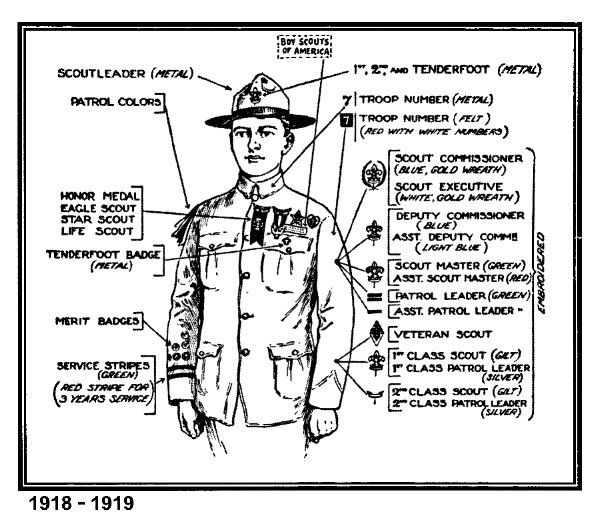
Note placement of ranks
Cloth badges for Second Class, First Class, Life and Star were first issues in 1913. Tenderfoot was thought of as a temporary rank and before 1921 was represented as a pin similar to the presentation of the Bobcat pin in Cub Scouts before it became a cloth badge.
Although Tenderfoot by itself was not issued as a cloth badge until 1921, Tenderfoot as a combination badge with scribe or bugler was issued in 1916 and 1917 respectively. Likewise, Second Class and First Class were issued in the same years with scribe and bugler. Since Life and Star were not worn on the sleeve, they were not made as combination badges.
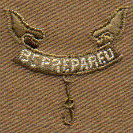
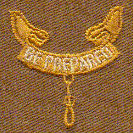 In these early years, the pins and cloth badges were issued in both gold and silver embroidering. Silver denoted the
scout was a patrol leader. Gold was for everyone else. Again, since only Second Class, First Class and Tenderfoot as a
combination badge were worn on the sleeve, only these ranks were made in gold and silver. Even with the silver badge,
scouts were given patrol leader and assistant patrol leader green bars cloth badges beginning in 1914 and senior patrol
leader in 1915.
In these early years, the pins and cloth badges were issued in both gold and silver embroidering. Silver denoted the
scout was a patrol leader. Gold was for everyone else. Again, since only Second Class, First Class and Tenderfoot as a
combination badge were worn on the sleeve, only these ranks were made in gold and silver. Even with the silver badge,
scouts were given patrol leader and assistant patrol leader green bars cloth badges beginning in 1914 and senior patrol
leader in 1915.
Until 1925, Life was earned before Star. In 1914, research indicates that the eagle's head may have faced both ways. From 1915-1924, the eagle heads for both Life and Star faced right. After the first Eagle cloth badge was issued in 1924 whose Eagle's head faced left, the Life and Star badges were redesigned to face left along with all the other ranks.
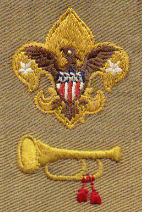 The combination badges are very interesting. Today, we would never go to the extra expense to have combinations of badges
made as one badge. Back then, apparently importance was placed upon looking sharp and clena by not having so many
individual badges sewn on the sleeve.
The combination badges are very interesting. Today, we would never go to the extra expense to have combinations of badges
made as one badge. Back then, apparently importance was placed upon looking sharp and clena by not having so many
individual badges sewn on the sleeve.
The Scribe combination badge began in 1916 and the Bugler combination badge began in 1917. They were discontinued in 1925. Each had two variations. The Scribe position had two distinct types of detailing in the quills. One has smooth-edged quills and the other has ruffled quills. The bugle tassels come in both red and gold. The red tassels are much more common.
The rank badges also had their variations in the types of embroidered eagles. Most of these variations are minor and usually relate to the number of tail feathers. The most notable difference is the thickness of the scroll in the Second Class and First Class badges as pictured on the variations page.
The early ranks had some different features compared to today's ranks. All the early ranks had a squatty/wide crown above the eagle with no line in the crown. The "BE PREPARED" scroll had a high smile as compared to a low smile today. And as mentioned above, the eagles head on the Life and Star faced right.
Tenderfoot Rank Badges: 1916-1925
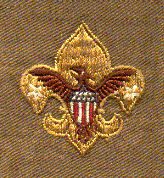
Tenderfoot
(1921-1938)
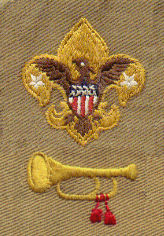
Tenderfoot - Bugler
(1917-1925)
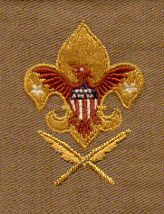
Tenderfoot - Scribe
(1916-1925)
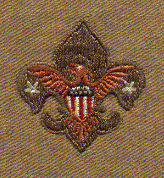
Tenderfoot
Patrol Leader
(1921-1938)
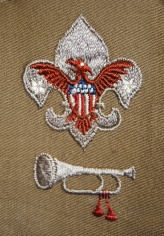
Tenderfoot - Bugler
Patrol Leader
(1917-1925)
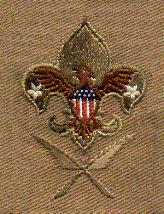
Tenderfoot - Scribe
Patrol Leader
(1916-1925)
Second Class Rank Badges: 1913-1925
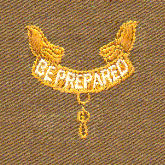
Second Class
(1913-1938)
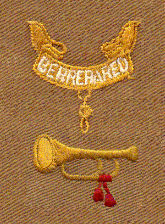
Second Class - Bugler
(1917-1925)
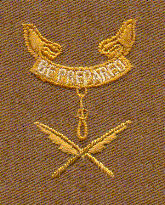
Second Class - Scribe
(1916-1925)

Second Class
Patrol Leader
(1913-1925)
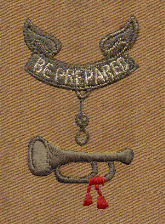
Second Class - Bugler
Patrol Leader
(1917-1925)
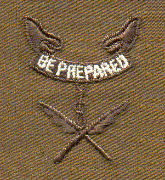
Second Class - Scribe
Patrol Leader
(1916-1925)
First Class: 1913-1925
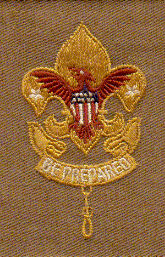
First Class
(1913-1938)
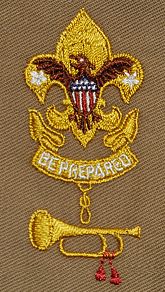
First Class - Bugler
(1917-1925)
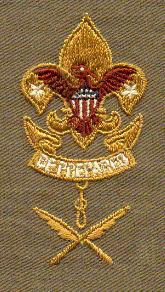
First Class - Scribe
(1916-1925)
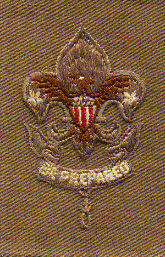
First Class
Patrol Leader
(1913-1925)
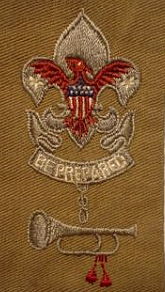
First Class - Bugler
Patrol Leader
(1917-1925)
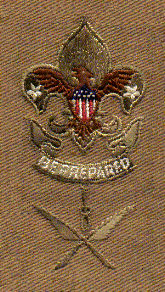
First Class - Scribe
Patrol Leader
(1916-1925)
Life, Star, and Eagle: 1914-1924
Life
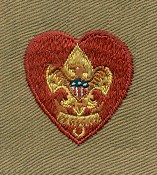
Life
(1914)

Life
(1915-1924)
Star
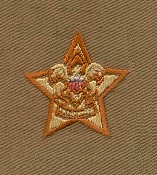
Star
(1914)
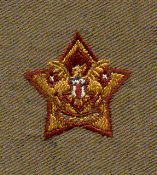
Star
(1915-1922)
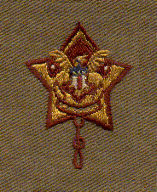
Star
(1923-1924)
Eagle
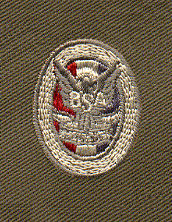
Eagle (Type 1)
(1924-1932)
More information on Eagle Scout Badges can be found here.
Variations in Rank Badges
Scroll Variation
One of the notable variations in the early rank badges was the height and width of the scroll. One was thicker and narrower, the other was thinner and wider. This variation occurred in both the Second Class and First Class badges, and in the silver patrol leader Second and First Class badges.
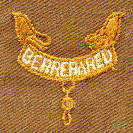
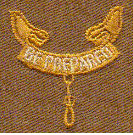
Quill Variation
Another notable variation in the early rank badges were the two distinct types of detailing in the quills. One has smooth-edged quills and the other has ruffled quills. These variations occured in all the scribe combination badges.
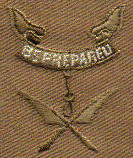
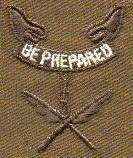
Scroll Change
In 1939, there were two significant changes in design to the rank badges. One change was the smile height of the scroll. The badges up to 1939 had a high smile and beginning in 1939, they had a new lower smile. This change occurred in both the Second Class and First Class badges.
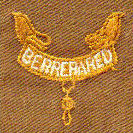
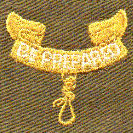
Credits:
- Myers, Paul. Collecting Boy Scout Rank Badges. Boy Scouts of America. 1999.
- Rank badges scanned from Ron Vinatieri's and the World Scouting Museum's collection.